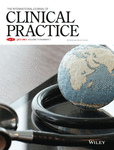Ureteral wall thickness is an independent parameter affecting the success of extracorporeal shock wave lithotripsy treatment in ureteral stones above the iliac crest
Abstract
Background
To investigate the relationship between ureteral wall thickness (UWT) and other variables of patients who underwent extracorporeal shock wave lithotripsy (SWL) in the primary treatment of the ureteral stone above the iliac crest level.
Material and Methods
A total of 147 patients aged 18 years and older, who underwent SWL in our clinic between December 2016 and December 2019 for the treatment of ureteral stones above the iliac crest level and had non-contrast enhanced abdominal computed tomography scans before the procedure were included in the clinical study. The results were evaluated at 3 months after SWL. The absence of residual fragments was considered as stone-free status, and the existence of any size residual fragment was considered as treatment failure.
Results
In our study, the mean age of the patients was 42.4 ± 12.8 years, and the stone-free rate was 92.5%. The median transverse stone size was 7.5 mm (min 2.8-max 15), and the median UWT was 4.2 mm (1-8.7). In the multivariate analysis, UWT (P = .002) and multiple stone presence (P = .027) were found to be independent factors affecting stone-free status. In the receiver operating characteristic curve analysis, the optimal threshold value for UWT was determined as 5.25 mm.
Conclusions
We found that UWT was the most important independent variable associated with increased failure in SWL treatment. The presence of multiple stones was another independent factor that increased the failure rates. Using SWL technology through experience accumulated with the mechanical hardware of the machine, we can select patients who are more suitable for this treatment and improve treatment outcomes.
DISCLOSURES
The authors declare that they have no conflict of interest.
Open Research
DATA AVAILABILITY STATEMENT
The datasets generated during and/or analysed during the current study are not publicly available due to Personal Data Protection Law but are available from the corresponding author on reasonable request.




